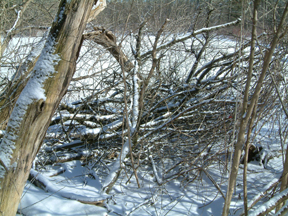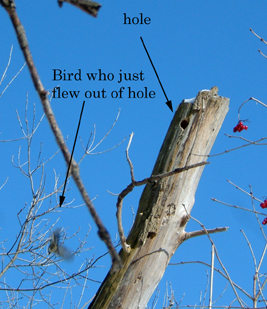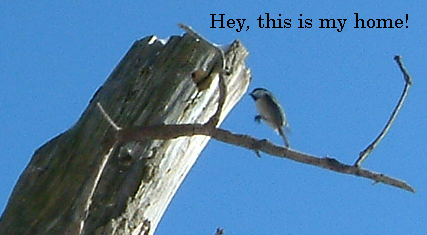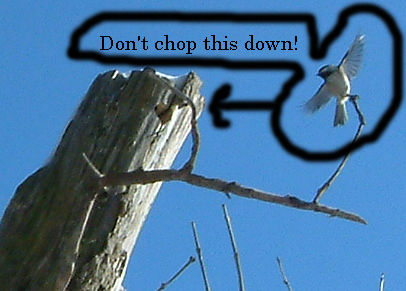This area in pink is from the northwest
corner of the lagoon to the west beach. The old Dunham Road went
through here, which explains why it is an area in need of major
restoration. After a site is disturbed, invasives and plants of
low floristic quality get a strong foothold. For example, the
predominant tree in this area is the box elder, a native tree of the
maple family. Its coefficient of conservation is a zero on the
floristic quality scale. This doesn't mean box elders are evil
and of no value, it means that this tree is able to grow quickly in a
disturbed site. The problem with its rapid growth is that the wood is
of low quality. The branches break off easily, which has occurred on
multiple occasions in this area. The large dead logs along the shore do
provide ideal wildlife habitat, and should be left undisturbed. There
is an excessive quantity of brush left over from winter 2004 tree
falls. This will be removed or chipped on site. There are some
grape vines growing on some of the box elder and norway maples in this
area. The grape vines are a native plant, with a coefficient of
conservation of 3. They provide food for wildlife, but can kill a tree
by pulling it over. The vines growing on cedars and trees that
esthetically important will be cut, otherwise the vines will not be
disturbed. A grape vine growing on a norway maple or box elder is
a net positive for the habitat. Standing dead trees are called
snags. They are rare in southeast Michigan because homeowners prefer
not to allow dead trees to stand. They do provide valuable habitat for
multiple species, include flying squirrels, bats and many birds.
Hardwood snags will be left standing.
The problems in this area include
1. Large area of english ivy on the lot side of the path
2. Extensive money plant on lot side of the path
3. Large number of norway maples
4. Large number of box elder trees
5. Other non-natives including rosa multiflora, european highbush cranberry, barberry
6. Large amount of japanese honeysuckle smothering native plants.
Objectives for this area include
1. Providing optimal habitat and native plant restoration
2. Screening of the houses from view from the lake and potentially the trail.
3. Eventual lower yearly maintenance costs with a reduction in the quantity of box elder near the path.
From a cost benefit perspective this area will be low yield compared to other areas of the greenbelt. Large sums of money and extensive volunteer effort will be required to completely rehabilitate this area. Options include...
Lot side of the path
1. "Give up". Keep the english ivy from crossing the path. Ignore the moneyplant. Remove fallen wood when it blocks the path. "Beat back" the japanese honeysuckle when it threatens valuable plants. 10 hours volunteer labor.
2. Gradual Control done with volunteer labor.
Start with removing money plant. Effective techniques will include herbicide as soon as plants emerge in monoculture areas then hand removal prior to flowering. This will be labor intensive, at least 30 hours and $20 worth of herbicide.
Second priority would be removal of japanese honeysuckle. This would require 6 hours of effort to apply herbicide as the plants emerge. $30 worth of herbicide.
Third priority would be removal of english ivy. English ivy has a waxy cuticle, thus simple herbicide application would not be effective. Control requires cutting the ivy, then spraying the new growth. This would require multiple visits. Estimated time at least 20 hours. Hand pulling is of limited effectiveness. $30 herbicide.
Fourth priority would be removal of 24% of the norway maples and 25% of the box elder per year. Rough estimate $2000.
After the invasives are controlled then planting of hazelnut, gray dogwood, red cedars and other native shrubs and trees could begin.
3. Do above all at once with hired labor estimate $7500 for the first year and $5000 per year for 4 years.
Lake side of path
Aggressively control invasives on the lake side of the path. Remove 25% of Norway Maples per year, remove all rosa multiflora, glossy buckthorn, and other invasives. Remove all fresh brush and 50% of brush that is smaller than 3 inches in diameter. Leave all large logs near the shoreline. Discourage placement of boats in this area. Plant spicebush, tulip trees and michigan holly. As spicebush and michigan holly grow, remove 25% european highbush cranberry per year. Minimum 20 hours for invasive removal, 8 hours for brush removal, $20 for herbicide and $2000 for tree removal. This will be probably be a 4 year project with possibly $2000 per year.

A brush pile left over from a recent box elder fall.
Some of these piles will be removed in 2005, but
some brush will be left to provide habitat. Where
brush piles are removed "No Boats" sign will go up.

This snag is being enjoyed by a winter bird.
Pictures take Feb 9, 2005. The red berries are
european highbush cranberry. A non-native
ornamental that has inedible berries.


The problems in this area include
1. Large area of english ivy on the lot side of the path
2. Extensive money plant on lot side of the path
3. Large number of norway maples
4. Large number of box elder trees
5. Other non-natives including rosa multiflora, european highbush cranberry, barberry
6. Large amount of japanese honeysuckle smothering native plants.
Objectives for this area include
1. Providing optimal habitat and native plant restoration
2. Screening of the houses from view from the lake and potentially the trail.
3. Eventual lower yearly maintenance costs with a reduction in the quantity of box elder near the path.
From a cost benefit perspective this area will be low yield compared to other areas of the greenbelt. Large sums of money and extensive volunteer effort will be required to completely rehabilitate this area. Options include...
Lot side of the path
1. "Give up". Keep the english ivy from crossing the path. Ignore the moneyplant. Remove fallen wood when it blocks the path. "Beat back" the japanese honeysuckle when it threatens valuable plants. 10 hours volunteer labor.
2. Gradual Control done with volunteer labor.
Start with removing money plant. Effective techniques will include herbicide as soon as plants emerge in monoculture areas then hand removal prior to flowering. This will be labor intensive, at least 30 hours and $20 worth of herbicide.
Second priority would be removal of japanese honeysuckle. This would require 6 hours of effort to apply herbicide as the plants emerge. $30 worth of herbicide.
Third priority would be removal of english ivy. English ivy has a waxy cuticle, thus simple herbicide application would not be effective. Control requires cutting the ivy, then spraying the new growth. This would require multiple visits. Estimated time at least 20 hours. Hand pulling is of limited effectiveness. $30 herbicide.
Fourth priority would be removal of 24% of the norway maples and 25% of the box elder per year. Rough estimate $2000.
After the invasives are controlled then planting of hazelnut, gray dogwood, red cedars and other native shrubs and trees could begin.
3. Do above all at once with hired labor estimate $7500 for the first year and $5000 per year for 4 years.
Lake side of path
Aggressively control invasives on the lake side of the path. Remove 25% of Norway Maples per year, remove all rosa multiflora, glossy buckthorn, and other invasives. Remove all fresh brush and 50% of brush that is smaller than 3 inches in diameter. Leave all large logs near the shoreline. Discourage placement of boats in this area. Plant spicebush, tulip trees and michigan holly. As spicebush and michigan holly grow, remove 25% european highbush cranberry per year. Minimum 20 hours for invasive removal, 8 hours for brush removal, $20 for herbicide and $2000 for tree removal. This will be probably be a 4 year project with possibly $2000 per year.
A brush pile left over from a recent box elder fall.
Some of these piles will be removed in 2005, but
some brush will be left to provide habitat. Where
brush piles are removed "No Boats" sign will go up.
This snag is being enjoyed by a winter bird.
Pictures take Feb 9, 2005. The red berries are
european highbush cranberry. A non-native
ornamental that has inedible berries.